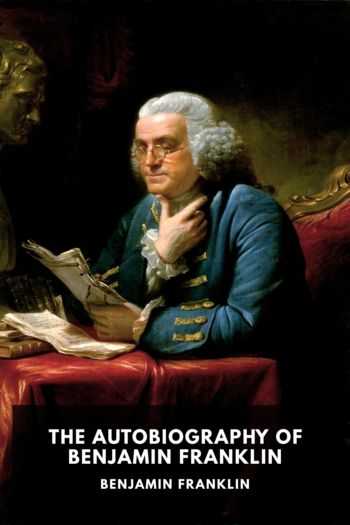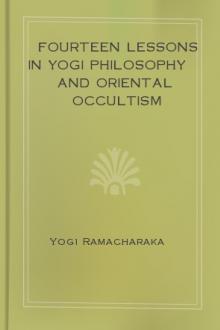Autobiography of a Yogi by Paramahansa Yogananda (self help books to read txt) 📕

- Author: Paramahansa Yogananda
- Performer: 978-0876120835
Book online «Autobiography of a Yogi by Paramahansa Yogananda (self help books to read txt) 📕». Author Paramahansa Yogananda
In this chapter of my autobiography I have obeyed my guru’s behest and spread the glad tiding, though it confound once more an incurious generation. Groveling, man knows well; despair is seldom alien; yet these are perversities, no part of man’s true lot. The day he wills, he is set on the path to freedom. Too long has he hearkened to the dank pessimism of his “dust-thou-art” counselors, heedless of the unconquerable soul.
I was not the only one privileged to behold the Resurrected Guru.
One of Sri Yukteswar’s chelas was an aged woman, affectionately known as MA (Mother), whose home was close to the Puri hermitage. Master had often stopped to chat with her during his morning walk. On the evening of March 16, 1936, Ma arrived at the ashram and asked to see her guru.
“Why, Master died a week ago!” Swami Sebananda, now in charge of the Puri hermitage, looked at her sadly.
“That’s impossible!” She smiled a little. “Perhaps you are just trying to protect the guru from insistent visitors?”
“No.” Sebananda recounted details of the burial. “Come,” he said, “I will take you to the front garden to Sri Yukteswarji’s grave.”
Ma shook her head. “There is no grave for him! This morning at ten o’clock he passed in his usual walk before my door! I talked to him for several minutes in the bright outdoors.
“‘Come this evening to the ashram,’ he said.
“I am here! Blessings pour on this old gray head! The deathless guru wanted me to understand in what transcendent body he had visited me this morning!”
The astounded Sebananda knelt before her.
“Ma,” he said, “what a weight of grief you lift from my heart! He is risen!”
{FN43-1} In SABIKALPA SAMADHI the devotee has spiritually progressed to a state of inward divine union, but cannot maintain his cosmic consciousness except in the immobile trance-state. By continuous meditation, he reaches the superior state of NIRBIKALPA SAMADHI, where he moves freely in the world and performs his outward duties without any loss of God-realization.
{FN43-2} Sri Yukteswar used the word PRANA; I have translated it as lifetrons. The Hindu scriptures refer not only to the ANU, “atom,” and to the PARAMANU, “beyond the atom,” finer electronic energies; but also to PRANA, “creative lifetronic force.” Atoms and electrons are blind forces; PRANA is inherently intelligent. The pranic lifetrons in the spermatozoa and ova, for instance, guide the embryonic development according to a karmic design.
{FN43-3} Adjective of MANTRA, chanted seed-sounds discharged by the mental gun of concentration. The PURANAS (ancient SHASTRAS or treatises) describe these MANTRIC wars between DEVAS and ASURAS (gods and demons). An ASURA once tried to slay a DEVA with a potent chant. But due to mispronunciation the mental bomb acted as a boomerang and killed the demon.
{FN43-4} Examples of such powers are not wanting even on earth, as in the case of Helen Keller and other rare beings.
{FN43-5} Lord Buddha was once asked why a man should love all persons equally. “Because,” the great teacher replied, “in the very numerous and varied lifespans of each man, every other being has at one time or another been dear to him.”
{FN43-6} The eight elemental qualities which enter into all created life, from atom to man, are earth, water, fire, air, ether, motion, mind, and individuality. (BHAGAVAD GITA: VII:4.)
{FN43-7} Body signifies any soul-encasement, whether gross or subtle. The three bodies are cages for the Bird of Paradise.
{FN43-8} Even as Babaji helped Lahiri Mahasaya to rid himself of a subconscious desire from some past life for a palace, as described in chapter 34.
{FN43-9} “And he said unto them, Wheresoever the body is, thither will the eagles be gathered together.”-LUKE 17:37. Wherever the soul is encased in the physical body or in the astral body or in the causal body, there the eagles of desires-which prey on human sense weaknesses, or on astral and causal attachments-will also gather to keep the soul a prisoner.
{FN43-10} “Him that overcometh will I make a pillar in the temple of my God, and he shall go no more out (i.e., shall reincarnate no more)… . To him that overcometh will I grant to sit with me in my throne, even as I also overcame, and am set down with my Father in his throne.”-REVELATION 3:12, 21.
{FN43-11} Sri Yukteswar was signifying that, even as in his earthly incarnation he had occasionally assumed the weight of disease to lighten his disciples’ karma, so in the astral world his mission as a savior enabled him to take on certain astral karma of dwellers on Hiranyaloka, and thus hasten their evolution into the higher causal world.
{FN43-12} Life and death as relativities of thought only. VEDANTA points out that God is the only Reality; all creation or separate existence is MAYA or illusion. This philosophy of monism received its highest expression in the UPANISHAD commentaries of Shankara.
CHAPTER: 44
WITH MAHATMA GANDHI AT WARDHA“Welcome to Wardha!” Mahadev Desai, secretary to Mahatma Gandhi, greeted Miss Bletch, Mr. Wright, and myself with these cordial words and the gift of wreaths of KHADDAR (homespun cotton). Our little group had just dismounted at the Wardha station on an early morning in August, glad to leave the dust and heat of the train. Consigning our luggage to a bullock cart, we entered an open motor car with Mr. Desai and his companions, Babasaheb Deshmukh and Dr. Pingale. A short drive over the muddy country roads brought us to MAGANVADI, the ashram of India’s political saint.
Mr. Desai led us at once to the writing room where, cross-legged, sat Mahatma Gandhi. Pen in one hand and a scrap of paper in the other, on his face a vast, winning, warm-hearted smile!
“Welcome!” he scribbled in Hindi; it was a Monday, his weekly day of silence.
Though this was our first meeting, we beamed on each other affectionately. In 1925 Mahatma Gandhi had honored the Ranchi school by a visit, and had inscribed in its guest-book a gracious tribute.
The tiny 100-pound saint radiated physical, mental, and spiritual health. His soft brown eyes shone with intelligence, sincerity, and discrimination; this statesman has matched wits and emerged the victor in a thousand legal, social, and political battles. No other leader in the world has attained the secure niche in the hearts of his people that Gandhi occupies for India’s unlettered millions. Their spontaneous tribute is his famous title-MAHATMA, “great soul.” {FN44-1} For them alone Gandhi confines his attire to the widely-cartooned loincloth, symbol of his oneness with the downtrodden masses who can afford no more.
[Illustration: MAHATMA GANDHI, I enjoy a quiet lunch with India’s political saint at his hermitage in Wardha, August, 1935.—see gandhi.jpg]
“The ashram residents are wholly at your disposal; please call on them for any service.” With characteristic courtesy, the Mahatma handed me this hastily-written note as Mr. Desai led our party from the writing room toward the guest house.
Our guide led us through orchards and flowering fields to a tile-roofed building with latticed windows. A front-yard well, twenty-five feet across, was used, Mr. Desai said, for watering stock; near-by stood a revolving cement wheel for threshing rice. Each of our small bedrooms proved to contain only the irreducible minimum-a bed, handmade of rope. The whitewashed kitchen boasted a faucet in one corner and a fire pit for cooking in another. Simple Arcadian sounds reached our ears-the cries of crows and sparrows, the lowing of cattle, and the rap of chisels being used to chip stones.
Observing Mr. Wright’s travel diary, Mr. Desai opened a page and wrote on it a list of SATYAGRAHA {FN44-2} vows taken by all the Mahatma’s strict followers (SATYAGRAHIS):
“Nonviolence; Truth; Non-Stealing; Celibacy; Non-Possession; Body-Labor; Control of the Palate; Fearlessness; Equal Respect for all Religions; SWADESHI (use of home manufactures); Freedom from Untouchability. These eleven should be observed as vows in a spirit of humility.”
(Gandhi himself signed this page on the following day, giving the date also-August 27, 1935.)
Two hours after our arrival my companions and I were summoned to lunch. The Mahatma was already seated under the arcade of the ashram porch, across the courtyard from his study. About twenty-five barefooted SATYAGRAHIS were squatting before brass cups and plates. A community chorus of prayer; then a meal served from large brass pots containing CHAPATIS (whole-wheat unleavened bread) sprinkled with GHEE; TALSARI (boiled and diced vegetables), and a lemon jam.
The Mahatma ate CHAPATIS, boiled beets, some raw vegetables, and oranges. On the side of his plate was a large lump of very bitter NEEM leaves, a notable blood cleanser. With his spoon he separated a portion and placed it on my dish. I bolted it down with water, remembering childhood days when Mother had forced me to swallow the disagreeable dose. Gandhi, however, bit by bit was eating the NEEM paste with as much relish as if it had been a delicious sweetmeat.
In this trifling incident I noted the Mahatma’s ability to detach his mind from the senses at will. I recalled the famous appendectomy performed on him some years ago. Refusing anesthetics, the saint had chatted cheerfully with his disciples throughout the operation, his infectious smile revealing his unawareness of pain.
The afternoon brought an opportunity for a chat with Gandhi’s noted disciple, daughter of an English admiral, Miss Madeleine Slade, now called Mirabai. {FN44-3} Her strong, calm face lit with enthusiasm as she told me, in flawless Hindi, of her daily activities.
“Rural reconstruction work is rewarding! A group of us go every morning at five o’clock to serve the near-by villagers and teach them simple hygiene. We make it a point to clean their latrines and their mud-thatched huts. The villagers are illiterate; they cannot be educated except by example!” She laughed gaily.
I looked in admiration at this highborn Englishwoman whose true Christian humility enables her to do the scavengering work usually performed only by “untouchables.”
“I came to India in 1925,” she told me. “In this land I feel that I have ‘come back home.’ Now I would never be willing to return to my old life and old interests.”
We discussed America for awhile. “I am always pleased and amazed,” she said, “to see the deep interest in spiritual subjects exhibited by the many Americans who visit India.” {FN44-4}
Mirabai’s hands were soon busy at the CHARKA (spinning wheel), omnipresent in all the ashram rooms and, indeed, due to the Mahatma, omnipresent throughout rural India.
Gandhi has sound economic and cultural reasons for encouraging the revival of cottage industries, but he does not counsel a fanatical repudiation of all modern progress. Machinery, trains, automobiles, the telegraph have played important parts in his own colossal life! Fifty years of public service, in prison and out, wrestling daily with practical details and harsh realities in the political world, have only increased his balance, open-mindedness, sanity, and humorous appreciation of the quaint human spectacle.
Our trio enjoyed a six o’clock supper as guests of Babasaheb Deshmukh. The 7:00 P.M. prayer hour found us back at the MAGANVADI ashram, climbing to the roof where thirty SATYAGRAHIS were grouped in a semicircle around Gandhi. He was squatting on a straw mat, an ancient pocket watch propped up before him. The fading sun cast a last gleam over the palms and banyans; the hum of night and the crickets had started. The atmosphere was serenity itself; I was enraptured.
A solemn chant led by Mr. Desai, with responses from the group; then a GITA reading. The Mahatma motioned to me to give the concluding prayer. Such divine unison of thought and aspiration! A memory forever: the Wardha roof top meditation under the early





Comments (0)